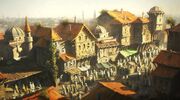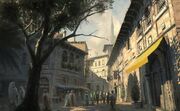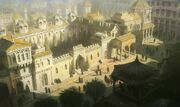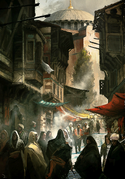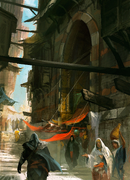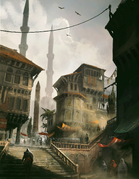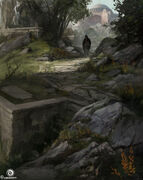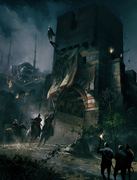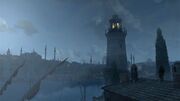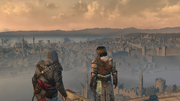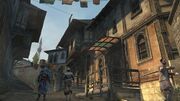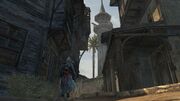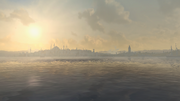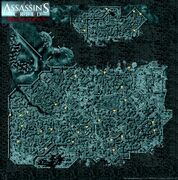小 (→参考与注释:本次编辑通过AWB自动完成) |
(搬运。) |
||
| 第1行: | 第1行: | ||
| + | {{Era|Locations}} |
||
| − | {{UC}}{{Era|Brotherhood|Revelations|RBook|PL|DYL}} |
||
| + | {{WP-REAL}} |
||
| − | {{地点信息 |
||
| + | {{翻译请求}} |
||
| − | |名称 = 君士坦丁堡 |
||
| + | {{Quote|The crossroads of the world. Many generations of men have ruled this city, but they have never subdued her. She always bounces back.|[[Yusuf Tazim]] regarding Constantinople, 1511.|Assassin's Creed: Revelations}} |
||
| ⚫ | |||
| + | {{Location infobox |
||
| − | |图像标题 = |
||
| ⚫ | |||
| − | |隐藏政治信息 = |
||
| + | |hidep = |
||
| − | |国家 = [[奥斯曼帝国]] |
||
| + | |state = [[Byzantine Empire]] (330–1204, 1261–1453)<br>{{wiki|Latin Empire}} (1204–1261)<br>[[Ottoman Empire]] (1453–1923)<br>[[Turkey|Republic of Turkey]] (1923–present) |
||
| − | |统治者 = 苏丹国 |
||
| + | |rulers = Autocracy (330–1204, 1261–1453)<br>Feudal monarchy (1204–1261)<br>Sultanate (1453–1923)<br> Parliamentary Republic (1923–present) |
||
| − | |派系 = [[拜占庭人]]<br>[[圣殿骑士]]<br>[[刺客]] |
||
| + | |factions = [[Byzantine Empire|Byzantines]]<br>[[Templars]]<br>[[Assassins]]<br>[[Romani]]<br>[[Thieves]]<br>[[Mercenaries]] |
||
| − | |隐藏历史信息 = |
||
| + | |hideh = |
||
| − | |创建 = [http://zh.wikipedia.org/wiki/%E5%90%9B%E5%A3%AB%E5%9D%A6%E4%B8%81%E4%B8%80%E4%B8%96_%28%E7%BD%97%E9%A9%AC%E5%B8%9D%E5%9B%BD%29 君士坦丁一世 (罗马帝国)] |
||
| + | |founded = [[Byzas]] (as {{Wiki|Byzantium}})<br>[[Constantine I]] (as Constantinople) |
||
| − | |时间 = 约公元前671 - 662年(名为[http://zh.wikipedia.org/wiki/%E6%8B%9C%E5%8D%A0%E5%BA%AD 拜占庭]) |
||
| + | |date = 658 BCE (as Byzantium)<br>324–330 CE (as Constantinople) |
||
| − | |废弃 = |
||
| + | |abandoned = |
||
| − | |隐藏其他信息 = |
||
| + | |hidea = |
||
| − | |地标 = [[托普卡帕宫]]<br>[[圣索菲亚大教堂]]<br>[[加拉达塔]] |
||
| + | |landmark = [[Hagia Sophia]]<br>[[Topkapı Palace]]<br>[[Galata Tower]]<br>[[Zeyrek Mosque]]<br>[[Myrelaion Church|Bodrum Mosque]] |
||
| − | |旗帜 = |
||
| − | | |
+ | |targets = [[Vali cel Tradat]]<br>[[Cyril of Rhodes]]<br>[[Georgios Kostas]]<br>[[Lysistrata]]<br>[[Mirela Djuric]]<br>[[Odai Dunqas]]<br>[[Tarik Barleti]]<br>[[Ahmet]]}} |
| − | |}} |
||
| − | {{Quote|一代又一代的人曾统治这座城市,但从未有人征服过她。她总能迅速恢复以往的活力。|优素福·塔齐姆|刺客信条:启示录}} |
||
| + | '''Constantinople''' (Byzantine Greek: ''Konstantinoupolis''; Latin: ''Constantinopolis'' or ''Byzantium''; Turkish: ''Kostantiniyye'' or ''İstanbul''), presently known as '''Istanbul''', was the capital of the [[Byzantine Empire]] and, following the city's [[Fall of Constantinople|conquest]] in 1453, became the [[Ottoman Empire]]'s capital in 1458. |
||
| − | '''君士坦丁堡'''(也叫'''康斯坦丁堡''',土耳其人称其为'''伊斯坦布尔''')是[[奥斯曼帝国]]的首都,也是世界上唯一一个跨洲城市。在文艺复兴时期,君士坦丁堡是欧洲最大也是最富裕的城市。它包含四个区域:[[康斯坦丁区]], [[巴耶济德区]], [[帝王区]]和[[加拉达区]]。 |
||
| + | The only major transcontinental city in the [[Earth|world]], during the [[Renaissance]], it was [[Europe]]'s largest and wealthiest city, consisting of four distinct districts: [[Constantine District|Constantine]], [[Bayezid District|Bayezid]], [[Imperial District|Imperial]], and [[Galata District|Galata]]. |
||
| − | ==历史== |
||
| − | 1204年,[[黎凡特刺客]][[导师]][[阿泰尔·伊本-拉阿哈德]]曾造访这座城市,他希望将[[刺客]]兄弟会组织引入这里。然而[[第四次十字军东征]]劫掠之后接踵而至的大规模暴乱又被迫使他离开这里。<ref name = "SC">[[刺客信条:秘密圣战]]</ref> |
||
| − | == |
+ | ==History== |
| + | ===Origins=== |
||
| − | *在[[刺客信条:启示录]]中,君士坦丁堡比罗马还要小一些,但建筑和人物更密集。 |
||
| + | The city began in 658 BCE as Byzantium, a modest city-state situated on {{Wiki|Seven hills of Istanbul|First Hill}}. It was founded by [[Byzas]], a devout soldier who had chosen the location based on a promising prophecy uttered by the [[Pythia|Oracle of Apollo]] at [[Sanctuary of Delphi|Delphi]]. The [[Golden Horn]] served as a natural port for the city.<ref name="ACR Database">''[[Assassin's Creed: Revelations]]'' – [[Database: Constantinople]]</ref> |
||
| − | *刺客信条系列的艺术指导Alxandre Amanico在E3曾说君士坦丁堡是[[Ezio]]和[[Altair]]见面的一个比喻——君士坦丁堡一半在欧洲,一半在亚洲。 |
||
| − | *Darby McDevitt也说过,君士坦丁堡曾经是基督徒控制的,后来又被穆斯林控制。Altair是在穆斯林文化中长大的,而Ezio则是在基督文化下成长的。 |
||
| + | Reportedly a rowdy port town, Byzantium was nevertheless considered an "island" of [[Greece|Hellenic]] civilization due to the many barbarian tribes that surrounded it. As time went on, both the city's inhabitants and its rulers diversified, with [[Sparta]]ns, [[Macedonia]]ns, [[Athens|Athenians]], and [[Romans]] all having controlled Byzantium at one point. In 408 BCE, the Athenian general [[Alkibiades]] ordered the construction of a [[Maiden's Tower|tower]] between Byzantium and Chrysopolis in order to control the movements of the Persian ships in the Bosphorus.<ref name="ACR Database"/> |
||
| − | ==画廊== |
||
| + | |||
| − | (请点击小图看大图) |
||
| + | ===Byzantine Empire=== |
||
| − | <gallery widths="250" captionalign="left"> |
||
| + | In 324 CE, the Roman Emperor [[Constantine I]], supposedly inspired by a vision from God, moved the capital of the [[Roman Empire]] to Byzantium, which he then rebuilt and expanded with [[Forum of the Ox|many]] [[Forum of Theodosius|fora]] as the [[Forum of Constantine]]. He also expanded the [[Hippodrome of Constantinople|Hippodrome]] of the city. He also ordered the constrution of the first church of the city, the [[Hagia Eirene]]. When construction was finished in 330 CE, he had the city rechristened ''Nova Roma Constantinopolitana'', or "New Rome, City of Constantine". Colloquially, it came to be known as both "Constantinopolis" and "New Rome", as the rulers still considered themselves Romans living in the Eastern Roman Empire.<ref name="ACR Database"/> During the reign of Constantine, a [[Roman Assassin|member]] of the [[Hidden Ones]] was active in the city.<ref name"ACU">''[[Assassin's Creed: Unity]]''</ref> |
||
| ⚫ | |||
| + | |||
| ⚫ | |||
| + | Around 361 CE, the Emperor [[Julian (emperor)|Julian]] built an [[Harbor of Julian]] close to the Hippodrome and the Great Palace. In 375 CE, [[Valens]] began the construction an [[Valens Aqueduct|aqueduct]] through the city.<ref name="ACR Database"/> |
||
| − | ACR Constantniople Port.jpg |
||
| + | |||
| ⚫ | |||
| + | From May to July 381 CE, the First Council of Constantinople took place in Hagia Irene.<ref name="ACR Database"/> |
||
| − | ACRIs.jpg |
||
| + | |||
| ⚫ | |||
| + | The Emperor [[Theodosius I]] made many construction in the city. He transported an [[Egypt]]ian [[Obelisk of Theodosius|obelisk]] from [[Alexandria]] to the Hippodrome of Constantinople. He also expanded the Harbor of Harbor of Eleutherios which became the [[Harbor of Theodosius]]. In 393 CE, he rebuilt the Forum Tauri which also took his name. In 403 CE, his successor and son [[Arcadius]] also built a [[Forum of Arcadius|forum]].<ref name="ACR Database"/> |
||
| + | |||
| + | In 455 CE, the Emperor [[Marcian]] erected a [[Column of Marcian|column]] for his glory.<ref name="ACR Database"/> |
||
| + | |||
| + | After the fall of the Western Roman Empire, Constantinople served as the capital of the Eastern Roman Empire, as well as a beacon of Christianity, while the West experienced barbarian attacks and economic hardship.<ref name="ACR Database"/> |
||
| + | |||
| + | At the beginning of the 6th century, the Emperor [[Anastasius I Dicorus]] built the [[Cistern of Mocius]] on the Seventh Hill of Constantinople.<ref name="ACR Database"/> |
||
| + | |||
| + | After the Nikia riots in 532 CE, the Emperor [[Justinian I]] rebuilt the [[Hagia Sophia]] and Hagia Eirene. The [[Little Hagia Sophia|Church of Saints Sergius and Bacchus]] was built during his reign. He also transformed a roman basilica in a [[Yerebatan Cistern|cistern]] for the Byzantine palace complex.<ref name="ACR Database"/> |
||
| + | |||
| + | Nevertheless, the city suffered its share of turmoil as well; in 1204, mass riots against the Emperor occurred, following which [[France|French]] and [[Republic of Venice|Venetian]] [[Fourth Crusade|Crusaders]] invaded and sacked Constantinople. As a result, [[Altaïr Ibn-La'Ahad]], [[Mentor]] of the [[Levantine Assassins]], could not carry out his intentions of introducing the [[Assassins|Assassin Brotherhood]] to the city and was forced to retreat.<ref>''[[Assassin's Creed: The Secret Crusade]]''</ref> |
||
| + | |||
| + | Captured by the invaders, Constantinople became part of the Latin Empire, leading to an influx of [[Venice|Venetian]] and [[Genoa|Genoese]] [[merchants]] that settled on the south and north side of the [[Golden Horn]] respectively. In 1258, an [[Assassins Guilds|Assassins Guild]] was established in the city by [[Niccolò Polo|Niccolò]] and [[Maffeo Polo]], who had come from the Assassin fortress of [[Masyaf]]. They also hid the five [[Masyaf Keys]] given to them by Altaïr in the [[Yerebatan Cistern]], the [[Maiden's Tower]], beneath the [[Forum of the Ox]], [[Galata Tower]] and what would become [[Topkapı Palace]].<ref name="ACR">''[[Assassin's Creed: Revelations]]''</ref> |
||
| + | |||
| + | In 1261, [[Michael VIII Palaiologos]], Greek heir to the Byzantine throne, marched on Constantinople and, after a decisive victory, managed to reclaim it. Yet, the recaptured city was struggling to survive; the Empire possessed but a mere fraction of its former land and power. Although Constantinople still flourished culturally, its population rapidly dwindled, leaving it an easy target for the continually expanding Ottoman Empire. The Byzantine Emperors attempted to get help from leaders in Western Europe, but ongoing wars and the complicated feelings held by the Catholic west concerning their Orthodox cousins led only to a series of half-hearted gestures and weak alliances.<ref name="ACR Database"/> |
||
| + | |||
| + | ===Ottoman Empire=== |
||
| + | In 1453, Constantinople was besieged by Sultan [[Mehmet II]] and his army. Although Byzantine Emperor [[Constantine XI Palaiologos]] managed to hold the city for 54 days, he and his forces were eventually defeated by the attackers, thanks to the [[Apple of Eden 6|Apple of Eden]] in Mehmet's possession.<ref name="Recollection">''[[Assassin's Creed: Recollection]]''</ref> Once Constantinople had officially come under Ottoman control, the [[Turkey|Turks]] made it their priority to restore the city to its former glory, with the Sultans being tolerant of different religions. As a result, Constantinople became attractive to all kinds of people, causing the population to grow once more. It was also around this period that the city began to be called Istanbul by many of its residents.<ref name="ACR Database"/> |
||
| + | |||
| + | During the Renaissance, at some point between 1501 and 1507, the Doge of [[Venice]], along with Sultan [[Bayezid II]], sought to ally their considerable naval powers through a free trade treaty. However, the [[Templars]] were wary of any peace between the two, and became intent on interfering with their alliance. The [[House of Borgia|Borgia family]] dispatched a force of [[mercenaries]] to disrupt the agreement, but they were quickly intercepted by members of the [[Italian Brotherhood of Assassins]], who set their [[Ships|ship]] aflame before they could depart.<ref>''[[Assassin's Creed: Project Legacy]]''</ref><ref>''[[Assassin's Creed: Brotherhood]]''</ref> |
||
| + | |||
| + | By 1509, the Templars had began to relocate themselves to Constantinople due to their defeat in [[Italy]] and the disruption of their activities throughout Western Europe. The Templars formed a faction known as the Stewards of Byzantium and attempted to seize control of the city in the wake of Bayezid's absence, due to his civil war with his son [[Selim I|Selim]].<ref name="ACR"/> |
||
| + | |||
| + | During this year, an {{Wiki|1509 Istanbul earthquake|earthquake}} uncovered one of the Masyaf Keys hidden beneath Topkapı Palace. Two years later, after traveling to Masyaf to research his Assassin heritage, [[Ezio Auditore da Firenze]], Mentor of the Italian Assassins, arrived in Constantinople to retrieve the other Keys before the Templars. His leadership enabled the Assassins to reclaim their [[Assassin Dens|dens]] from the Byzantines and liberated most of the shops from their control, much as he had in [[Rome]], as well as training several Assassins to the rank of [[Master Assassin]] through the assassination of key Templar agents. However, when Selim took control of the throne, he banished Ezio from Constantinople,<ref name="ACR"/> though allowed him one final visit to the city to sort out his affairs, by request of his son [[Suleiman I|Suleiman]].<ref>''[[Assassin's Creed: Revelations (novel)]]''</ref> |
||
| + | |||
| + | ==Trivia== |
||
| + | *[[Bernardo Baroncelli]], one of the [[Pazzi conspiracy|Pazzi conspirators]], fled to Constantinople following the failed attempt to take over [[Florence]]. |
||
| + | *In ''[[Assassin's Creed: Revelations]]'', the city was slightly smaller than Rome was in ''[[Assassin's Creed: Brotherhood]]'', but it had more buildings, and was more densely populated. |
||
| + | *[[Alexandre Amancio]], the Creative Director of the [[Assassin's Creed (series)|''Assassin's Creed'' series]], stated at E3 that Constantinople is a "really cool metaphor for Ezio meeting Altaïr", citing the fact that half of Constantinople was in Europe, and the other in Asia. |
||
| + | *It was also stated by [[Darby McDevitt]] that Constantinople would be a meaningful meeting of Ezio and Altaïr as the city itself was formerly under Christian control, then Muslim, which suited Altaïr and Ezio as the former hailed from a Muslim culture in [[Syria]] and the latter hailed from a Christian Italy. |
||
| + | *Constantinople was originally meant to be included in ''[[Assassin's Creed]]''.{{Fact|June 2019}} |
||
| + | *In ''Assassin's Creed: Revelations'', it is only possible to explore the section of the city within the {{Wiki|Walls of Constantinople#|Wall of Constantine}} and Galata, despite the fact that the Wall of Constantine had been superseded by the {{Wiki|Walls of Constantinople#Theodosian Walls|Theodosian Walls}} almost a thousand years beforehand and little remained of it. The rest of the city, which is wholly inaccessible, can be seen from high locations such as top of the Galata Tower and the minarets of the [[Fatih Mosque|Fatih Camii]]. |
||
| + | |||
| + | ==Gallery== |
||
| + | <tabber> |
||
| + | Concept art= |
||
| + | <gallery captionalign="center" position="center" spacing="small" widths="180"> |
||
| + | constantinople.png|Constantinople panorama |
||
| ⚫ | |||
| ⚫ | |||
| + | ACR Imperial District Port - Concept Art.jpg|Imperial district port |
||
| + | ACR Constantinople Port - Concept Art.jpg|Imperial district port |
||
| + | Olivier Martin ACR Concept.JPG|Port market |
||
| + | Rich district of Constantinople by Olivier Martin.jpg|Rich district buildings |
||
| + | Assassin's creed Revelations shanty district by Omartin.jpg|Poor district buildings |
||
| + | Constantinople Poor District 1.jpg|Poor district |
||
| + | ACR Constantine District - Concept Art.jpg|Poor district |
||
| + | Constantinople Rich District by Gilles Beloeil.jpg|Rich district |
||
| + | Rich District ACR.jpg|Rich district |
||
| ⚫ | |||
| + | ACR Street Art 2 HD.png|Streets of Constantinople |
||
| + | ACR Street Art 3 HD.png|Streets of Constantinople |
||
| ⚫ | |||
| + | ACR Constantinople Gates Art HD.png|Constantinople gates |
||
| + | Contantinople by night concept art by Francis Denoncourt.jpg|Constantinople by night |
||
| + | Istanbul Rooftops concept by Donglu Yu.jpg|Constantinople rooftops |
||
| + | PL MyEnemysEnemy.jpg|Artwork from ''[[Assassin's Creed: Project Legacy]]'' |
||
| + | </gallery> |
||
| + | |-| |
||
| + | Screenshots= |
||
| + | <gallery captionalign="center" position="center" spacing="small" widths="180"> |
||
| + | Constantinople at night.jpg|Constantinople at night |
||
| + | The view 3.png|Ezio and Yusuf looking out over Constaninople from Galata Tower |
||
| + | Arcadia district of Constantinople.jpg|Arcadia district of Constantinople |
||
| + | Constantinople poor district.jpg|Constantinople’s poor district |
||
| + | Poor district of Constantinople 2.jpg|Poor district of Constantinople |
||
| + | Poor district of Constantinople.jpg|Poor district of Constantinople |
||
| + | Constantinople at night - Panoramic.png|Constantinople at night panorama |
||
| + | Constantinoplepanoramic.png|Constantinople as seen from the Bosphorus |
||
| + | acr-revelation-map-constantinople-galata.jpg|Map of the city |
||
</gallery> |
</gallery> |
||
| + | </tabber> |
||
| − | == |
+ | ==Appearances== |
| + | *''[[Assassin's Creed: Project Legacy]]'' {{Mo}} |
||
| − | {{参考列表}} |
||
| + | *''[[Assassin's Creed: Brotherhood]]'' {{Mo}} |
||
| + | *''[[Assassin's Creed: Revelations]]'' {{1st}} |
||
| + | *[[Assassin's Creed: Revelations (novel)|''Assassin's Creed: Revelations'' novel]] |
||
| + | *''[[Assassin's Creed: Recollection]]'' {{Mo}} |
||
| + | *''[[Assassin's Creed: Odyssey]]'' {{Mo|Byzantium}} |
||
| ⚫ | |||
| − | '''本页面待补充''' |
||
| + | {{Reflist}} |
||
{{ACR}} |
{{ACR}} |
||
| + | |||
| ⚫ | |||
| − | [[pl:Konstantynopol]] |
||
| ⚫ | |||
[[de:Konstantinopel]] |
[[de:Konstantinopel]] |
||
[[es:Constantinopla]] |
[[es:Constantinopla]] |
||
| ⚫ | |||
| ⚫ | |||
[[fr:Constantinople]] |
[[fr:Constantinople]] |
||
| + | [[hu:Konstantinápoly]] |
||
| ⚫ | |||
| + | [[nl:Constantinopel]] |
||
| ⚫ | |||
| ⚫ | |||
| ⚫ | |||
| + | [[en:Constantinople]] |
||
{{DEFAULTSORT:JunShiTanDingBao}} |
{{DEFAULTSORT:JunShiTanDingBao}} |
||
| + | |||
| + | {{References}} |
||
[[Category:所有页面]] |
[[Category:所有页面]] |
||
[[Category:地点]] |
[[Category:地点]] |
||
| 第61行: | 第139行: | ||
[[Category:欧洲城市]] |
[[Category:欧洲城市]] |
||
[[Category:城市]] |
[[Category:城市]] |
||
| ⚫ | |||
2019年7月4日 (四) 11:43的版本
| 兄弟会需要你的帮助! 本条目包含未翻译内容。您可以帮助刺客信条维基来 翻译这个条目。 |
- “The crossroads of the world. Many generations of men have ruled this city, but they have never subdued her. She always bounces back.”
- ―Yusuf Tazim regarding Constantinople, 1511.[来源]
Constantinople (Byzantine Greek: Konstantinoupolis; Latin: Constantinopolis or Byzantium; Turkish: Kostantiniyye or İstanbul), presently known as Istanbul, was the capital of the Byzantine Empire and, following the city's conquest in 1453, became the Ottoman Empire's capital in 1458.
The only major transcontinental city in the world, during the Renaissance, it was Europe's largest and wealthiest city, consisting of four distinct districts: Constantine, Bayezid, Imperial, and Galata.
History
Origins
The city began in 658 BCE as Byzantium, a modest city-state situated on First Hill. It was founded by Byzas, a devout soldier who had chosen the location based on a promising prophecy uttered by the Oracle of Apollo at Delphi. The Golden Horn served as a natural port for the city.[1]
Reportedly a rowdy port town, Byzantium was nevertheless considered an "island" of Hellenic civilization due to the many barbarian tribes that surrounded it. As time went on, both the city's inhabitants and its rulers diversified, with Spartans, Macedonians, Athenians, and Romans all having controlled Byzantium at one point. In 408 BCE, the Athenian general Alkibiades ordered the construction of a tower between Byzantium and Chrysopolis in order to control the movements of the Persian ships in the Bosphorus.[1]
Byzantine Empire
In 324 CE, the Roman Emperor Constantine I, supposedly inspired by a vision from God, moved the capital of the Roman Empire to Byzantium, which he then rebuilt and expanded with many fora as the Forum of Constantine. He also expanded the Hippodrome of the city. He also ordered the constrution of the first church of the city, the Hagia Eirene. When construction was finished in 330 CE, he had the city rechristened Nova Roma Constantinopolitana, or "New Rome, City of Constantine". Colloquially, it came to be known as both "Constantinopolis" and "New Rome", as the rulers still considered themselves Romans living in the Eastern Roman Empire.[1] During the reign of Constantine, a member of the Hidden Ones was active in the city.[2]
Around 361 CE, the Emperor Julian built an Harbor of Julian close to the Hippodrome and the Great Palace. In 375 CE, Valens began the construction an aqueduct through the city.[1]
From May to July 381 CE, the First Council of Constantinople took place in Hagia Irene.[1]
The Emperor Theodosius I made many construction in the city. He transported an Egyptian obelisk from Alexandria to the Hippodrome of Constantinople. He also expanded the Harbor of Harbor of Eleutherios which became the Harbor of Theodosius. In 393 CE, he rebuilt the Forum Tauri which also took his name. In 403 CE, his successor and son Arcadius also built a forum.[1]
In 455 CE, the Emperor Marcian erected a column for his glory.[1]
After the fall of the Western Roman Empire, Constantinople served as the capital of the Eastern Roman Empire, as well as a beacon of Christianity, while the West experienced barbarian attacks and economic hardship.[1]
At the beginning of the 6th century, the Emperor Anastasius I Dicorus built the Cistern of Mocius on the Seventh Hill of Constantinople.[1]
After the Nikia riots in 532 CE, the Emperor Justinian I rebuilt the Hagia Sophia and Hagia Eirene. The Church of Saints Sergius and Bacchus was built during his reign. He also transformed a roman basilica in a cistern for the Byzantine palace complex.[1]
Nevertheless, the city suffered its share of turmoil as well; in 1204, mass riots against the Emperor occurred, following which French and Venetian Crusaders invaded and sacked Constantinople. As a result, Altaïr Ibn-La'Ahad, Mentor of the Levantine Assassins, could not carry out his intentions of introducing the Assassin Brotherhood to the city and was forced to retreat.[3]
Captured by the invaders, Constantinople became part of the Latin Empire, leading to an influx of Venetian and Genoese merchants that settled on the south and north side of the Golden Horn respectively. In 1258, an Assassins Guild was established in the city by Niccolò and Maffeo Polo, who had come from the Assassin fortress of Masyaf. They also hid the five Masyaf Keys given to them by Altaïr in the Yerebatan Cistern, the Maiden's Tower, beneath the Forum of the Ox, Galata Tower and what would become Topkapı Palace.[4]
In 1261, Michael VIII Palaiologos, Greek heir to the Byzantine throne, marched on Constantinople and, after a decisive victory, managed to reclaim it. Yet, the recaptured city was struggling to survive; the Empire possessed but a mere fraction of its former land and power. Although Constantinople still flourished culturally, its population rapidly dwindled, leaving it an easy target for the continually expanding Ottoman Empire. The Byzantine Emperors attempted to get help from leaders in Western Europe, but ongoing wars and the complicated feelings held by the Catholic west concerning their Orthodox cousins led only to a series of half-hearted gestures and weak alliances.[1]
Ottoman Empire
In 1453, Constantinople was besieged by Sultan Mehmet II and his army. Although Byzantine Emperor Constantine XI Palaiologos managed to hold the city for 54 days, he and his forces were eventually defeated by the attackers, thanks to the Apple of Eden in Mehmet's possession.[5] Once Constantinople had officially come under Ottoman control, the Turks made it their priority to restore the city to its former glory, with the Sultans being tolerant of different religions. As a result, Constantinople became attractive to all kinds of people, causing the population to grow once more. It was also around this period that the city began to be called Istanbul by many of its residents.[1]
During the Renaissance, at some point between 1501 and 1507, the Doge of Venice, along with Sultan Bayezid II, sought to ally their considerable naval powers through a free trade treaty. However, the Templars were wary of any peace between the two, and became intent on interfering with their alliance. The Borgia family dispatched a force of mercenaries to disrupt the agreement, but they were quickly intercepted by members of the Italian Brotherhood of Assassins, who set their ship aflame before they could depart.[6][7]
By 1509, the Templars had began to relocate themselves to Constantinople due to their defeat in Italy and the disruption of their activities throughout Western Europe. The Templars formed a faction known as the Stewards of Byzantium and attempted to seize control of the city in the wake of Bayezid's absence, due to his civil war with his son Selim.[4]
During this year, an earthquake uncovered one of the Masyaf Keys hidden beneath Topkapı Palace. Two years later, after traveling to Masyaf to research his Assassin heritage, Ezio Auditore da Firenze, Mentor of the Italian Assassins, arrived in Constantinople to retrieve the other Keys before the Templars. His leadership enabled the Assassins to reclaim their dens from the Byzantines and liberated most of the shops from their control, much as he had in Rome, as well as training several Assassins to the rank of Master Assassin through the assassination of key Templar agents. However, when Selim took control of the throne, he banished Ezio from Constantinople,[4] though allowed him one final visit to the city to sort out his affairs, by request of his son Suleiman.[8]
Trivia
- Bernardo Baroncelli, one of the Pazzi conspirators, fled to Constantinople following the failed attempt to take over Florence.
- In Assassin's Creed: Revelations, the city was slightly smaller than Rome was in Assassin's Creed: Brotherhood, but it had more buildings, and was more densely populated.
- Alexandre Amancio, the Creative Director of the Assassin's Creed series, stated at E3 that Constantinople is a "really cool metaphor for Ezio meeting Altaïr", citing the fact that half of Constantinople was in Europe, and the other in Asia.
- It was also stated by Darby McDevitt that Constantinople would be a meaningful meeting of Ezio and Altaïr as the city itself was formerly under Christian control, then Muslim, which suited Altaïr and Ezio as the former hailed from a Muslim culture in Syria and the latter hailed from a Christian Italy.
- Constantinople was originally meant to be included in Assassin's Creed. [来源请求]
- In Assassin's Creed: Revelations, it is only possible to explore the section of the city within the Wall of Constantine and Galata, despite the fact that the Wall of Constantine had been superseded by the Theodosian Walls almost a thousand years beforehand and little remained of it. The rest of the city, which is wholly inaccessible, can be seen from high locations such as top of the Galata Tower and the minarets of the Fatih Camii.
Gallery
Appearances
- Assassin's Creed: Project Legacy (仅提及)
- Assassin's Creed: Brotherhood (仅提及)
- Assassin's Creed: Revelations (首次登场)
- Assassin's Creed: Revelations novel
- Assassin's Creed: Recollection (仅提及)
- Assassin's Creed: Odyssey (仅提及,作为Byzantium)
References
- ↑ 1.00 1.01 1.02 1.03 1.04 1.05 1.06 1.07 1.08 1.09 1.10 1.11 Assassin's Creed: Revelations – Database: Constantinople
- ↑ Assassin's Creed: Unity
- ↑ Assassin's Creed: The Secret Crusade
- ↑ 4.0 4.1 4.2 Assassin's Creed: Revelations
- ↑ Assassin's Creed: Recollection
- ↑ Assassin's Creed: Project Legacy
- ↑ Assassin's Creed: Brotherhood
- ↑ Assassin's Creed: Revelations (novel)
| |||||||||||||||||||||||||||||||||||||
| 如果您认为本词条还需改进,欢迎参与编辑。任何疑问请阅读欢迎页面或这里留言。 |










